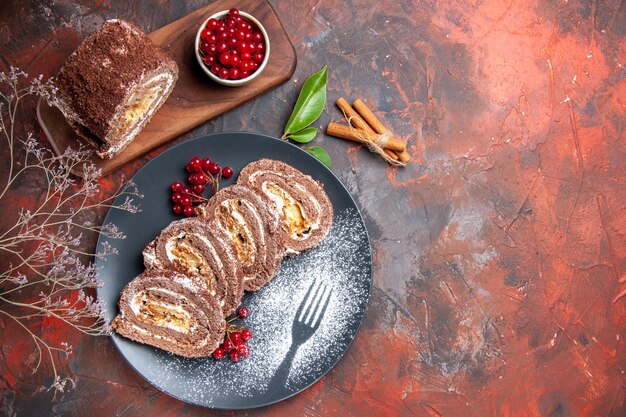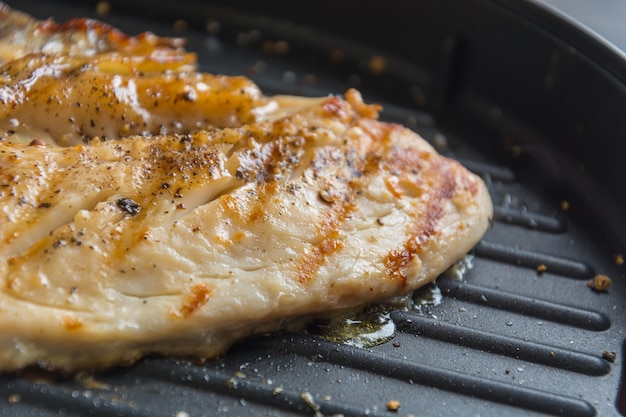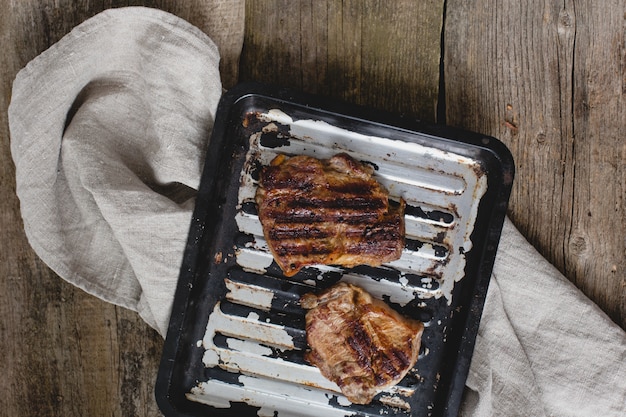Let's be honest, there's something undeniably satisfying about a perfectly roasted pork loin. It's a dish that's guaranteed to impress, but getting it right can be tricky. Too often, we're left with a dry, overcooked piece of meat that just doesn't live up to the hype. But fear not! This ultimate guide is packed with tips, tricks, and insights gleaned from years of cooking, so you can confidently whip up a juicy, flavour-packed pork loin that'll leave everyone wanting more.
(Part 1) Choosing Your Pork Loin: The Foundation of a Great Roast

Bone-in or Boneless? It's a Matter of Preference
First things first, we need the star of the show: the pork loin. You'll find it at your local butcher or supermarket, and while the decision of bone-in versus boneless is a personal one, I'm a big fan of the bone-in variety. Why? For me, it's all about flavour. The bone adds a depth of richness that's simply unmatched. Plus, it helps to keep the meat moist during cooking, a real bonus for those of us who hate dry pork.
Size Matters: Finding the Perfect Fit
Now, let's talk size. For a family gathering or a dinner party, a 3-4 pound pork loin is ideal. It's substantial enough to feed a crowd, but not so big that it takes ages to cook. If you're cooking for fewer people, a smaller loin will work perfectly. Don't be afraid to ask your butcher for advice; they're usually happy to help.
Look for Fat: Nature's Built-in Moisture
Here's a little secret: fat is your friend when it comes to pork loin. A good layer of fat running along the top of the loin is what gives you that juicy, succulent texture we all crave. It renders during cooking, releasing flavour and keeping the meat moist. So, when you're picking your pork loin, don't shy away from a little bit of fat.
(Part 2) Prepping Your Pork Loin: Unlocking the Flavour

Trimming the Fat: A Balancing Act
Now, you've got your pork loin, but it needs a little TLC. I recommend trimming any excess fat, but not all of it. Remember, we want that fat to render and infuse the meat with its delicious goodness. Just trim the bits that are loose or not attached to the meat itself. This will help to prevent your roast from being greasy.
Seasoning with Confidence: Let Your Flavours Shine
Here's where the real fun begins: seasoning! This is your chance to let your culinary creativity shine. A classic blend of salt, pepper, and garlic powder always works wonders, but feel free to experiment with different herbs and spices to match your taste. A sprinkle of rosemary, thyme, or even a touch of smoked paprika can elevate your pork loin to new heights. Remember, a little goes a long way!
Taking it to the Next Level: Brining for Unrivalled Juiciness
For those who want to really push the boundaries of flavour and tenderness, brining is a technique worth exploring. It involves soaking the pork loin in a salt solution before cooking, which draws out moisture and then redistributes it during cooking. The result? A melt-in-your-mouth pork loin that's bursting with flavour.
Here's a simple brine recipe:
1 cup kosher salt
1 cup sugar
4 cups water
Dissolve the salt and sugar in the water, then submerge the pork loin in the brine for 2-4 hours. Remember, brining is optional, but highly recommended!
(Part 3) Roasting to Perfection: The Key to a Juicy Masterpiece

Temperature is King: The Secret to Even Cooking
Now, let's talk oven time. The key to a perfect roast is cooking at the right temperature. I always recommend 350°F (175°C). This ensures even cooking and prevents the outside from burning before the inside is fully cooked. Trust me, no one wants a burnt crust and raw centre!
Searing for a Flavorful Crust: The First Step to Deliciousness
Before your pork loin goes into the oven, give it a quick sear in a hot pan. This creates that beautiful golden-brown crust we all love, and it also helps to seal in the juices. I use a heavy-bottomed pan for this, as it distributes heat more evenly. Add a little bit of oil to the pan and let it get good and hot before adding the pork loin. Sear it on all sides for a few minutes, then transfer it to your roasting pan.
Monitoring the Roast: Keeping an Eye on Progress
Once in the oven, keep an eye on your pork loin. It should be browning nicely and the fat should be rendering. This means it's on the right track! If you're feeling extra cautious, use a meat thermometer to check the internal temperature.
(Part 4) The Rest Period: A Crucial Step for Juiciness
Let It Rest: Allowing the Juices to Redistribute
Now, here's where many people go wrong. After cooking, it's tempting to carve into your pork loin straight away, but resist the urge! Let it rest for 10-15 minutes before carving. This allows the juices to redistribute throughout the meat, ensuring a tender and succulent roast. Cover it with foil to keep it warm while it rests.
(Part 5) Carving Time: A Skill Worth Mastering
Slicing with Precision: The Art of Carving
It's time for the grand finale: carving your pork loin. Use a sharp carving knife to slice against the grain of the meat. This will ensure that the slices are tender and easy to eat. If you're not comfortable carving, you can always ask your butcher to do it for you.
(Part 6) side dishes: Completing the Culinary Experience
Perfect Pairings: Elevating Your Pork Loin
Now that you've got your succulent pork loin, let's talk sides. There are endless possibilities for pairing your roast. A big green salad with a tangy vinaigrette adds freshness and lightness, while roasted vegetables provide a burst of flavour and colour. mashed potatoes, creamy and comforting, are a classic choice.
Table Talk: Personalizing Your Meal
Ultimately, the best side dishes are the ones you and your guests enjoy. Don't be afraid to get creative and try new things.
(Part 7) Mastering the Meat Thermometer: Ensuring food safety and Perfection
The Right Tool: A Must-Have for Every Kitchen
A meat thermometer is a crucial tool for cooking pork loin to perfection. It takes the guesswork out of determining whether the meat is cooked through and ensures that it's safe to eat.
Target Temperature: Achieving that Perfect Doneness
The target internal temperature for pork loin is 145°F (63°C). Insert the thermometer into the thickest part of the meat, away from the bone.
Resting Matters: Allowing for Carry-Over Cooking
The temperature will continue to rise slightly as the pork loin rests, so take it out of the oven when it's about 5°F (3°C) below your target temperature. This will ensure that it reaches the safe internal temperature while resting.
(Part 8) Common Pitfalls and Troubleshooting: Avoiding the Common Mistakes
Dry Pork Loin: A Problem with a Solution
A dry pork loin is a common culinary disappointment. The most common reason is overcooking. Pork loin is a lean cut of meat, so it needs to be cooked carefully to avoid drying out.
Preventing Dryness: Tips for a juicy roast
To prevent dryness, make sure you don't overcook your pork loin. Use a meat thermometer to check the internal temperature, and remove the roast from the oven when it reaches 145°F (63°C). Always let the roast rest for 10-15 minutes before carving.
(Part 9) FAQs: Addressing Your Most Common Questions
crispy skin: Unlocking the Secret to a Delicious Crust
Q: What are some tips for making a crispy skin on my pork loin?
A: To get that irresistible crispy skin, start by patting the pork loin dry with paper towels. Then, score the fat with a sharp knife, making diagonal cuts about 1/2 inch apart. This helps the fat render more evenly and creates a crispy crust. You can also roast the pork loin at a higher temperature for the first 30 minutes to help crisp up the skin.
Big Loins: Cooking Large Pork Loins
Q: What if my pork loin is too big for my oven?
A: If your pork loin is too big for your oven, you can cook it in two pieces. Simply cut the loin in half lengthwise, then roast each piece separately. Adjust the cooking time accordingly.
Freezing Pork Loin: A Tip for Future Meals
Q: Can I freeze pork loin?
A: Yes, you can freeze pork loin. Wrap it tightly in plastic wrap, then place it in a freezer-safe bag. Frozen pork loin will keep for up to 3 months. To thaw, place it in the refrigerator overnight.
leftover pork loin: Ideas for Delicious Meals
Q: What are some creative ways to use leftover pork loin?
A: Leftover pork loin is a versatile ingredient. Use it for sandwiches, salads, or pasta dishes. You can also make soup, stew, or stir-fry. Get creative and experiment with different flavours and textures. It's a great way to stretch out your dinner and avoid food waste.
Making Gravy: Adding a Final Touch of Flavour
Q: What are some tips for making a delicious gravy from the pan drippings?
A: To make a delicious gravy, first, pour off any excess fat from the pan. Then, add a few tablespoons of flour to the pan and whisk it into the drippings. Add a cup of broth to the pan and bring it to a simmer. Cook until the gravy has thickened, then season to taste with salt and pepper.
(Part 10) The Final Verdict: Your Journey to perfect pork loin
So, there you have it. With this comprehensive guide, you have all the tools and knowledge you need to confidently roast the most delicious pork loin you've ever tasted. Remember, practice makes perfect. With each roast, you'll refine your skills and master the art of creating a truly exceptional meal. Now, go forth and conquer the kitchen!
Everyone is watching

Corn on the Cob: The Ultimate Guide to Perfectly Cooked Ears
Healthy MealsAh, corn on the cob. Just the name evokes images of sunny days, barbecues, and that sweet, juicy flavour that ...

Perfect Pork Roast Oven Cooking Time: A Guide to Delicious Results
Healthy MealsThere's something truly satisfying about a perfectly roasted pork. The aroma alone is enough to make your mout...

Ham Cooking Time: How Long to Bake, Smoke, or Boil a Delicious Ham
Healthy MealsAh, ham. It's a classic, isn't it? A real crowd-pleaser, especially around holidays. And when done right, it'...

Scallops: The Ultimate Guide to Perfect Cooking
Healthy MealsAh, scallops. Those delicate, sweet, and utterly delicious morsels of the sea. They hold a special place in my...

Spaghetti Squash: The Ultimate Guide to Cooking and Serving
Healthy MealsRemember that time you saw spaghetti squash at the supermarket, looking all bumpy and strange, and thought, "W...
